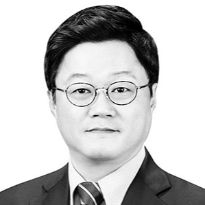Using Korea’s memory chip strength as leverage

Choo Jae-woo
The author is a professor at the Graduate School of Pan-Pacific International Studies, Kyung Hee University.
Good news broke for the Korean chip industry in early October. The U.S. Department of Commerce reversed its earlier ban on exporting chip equipment to China. Thanks to the revocation, Samsung Electronics and SK hynix can now normalize their operation at the NAND flash factory in Xi’an and the D-RAM plant in Wuxi, respectively, from now.
But suspicions linger over the about-turn. In the strategic competition between the United States and China, the U.S. reaped the gains by choking the Chinese economy, using chips as a weapon. Then, why such a sudden change of direction? The Yoon Suk Yeol administration gladly packaged the reversal as a “victory of the reinforced Korea-U.S. alliance.” Is it really?
The U.S. has been seeking to improve its relations with China since early this year after the National People’s Congress and the Chinese People’s Political Consultative Conference both declared the reopening of the country after the pandemic. The U.S. may have expected a trickle-down effect from Beijing’s zero-Covid policy starting in 2021. At that time, while the Chinese economy managed to achieve an 8.11 percent growth on year, the world economy grew 5.87 percent and the U.S. economy 5.95 percent. The Korean economy showed a 4.15 percent growth. In particular, the U.S.’s export to China increased 145 percent from the previous year while its imports from China grew 132 percent.
In the U.S., election season has begun since the first TV debate was held in August among presidential candidates of the Republican Party. As seen in the past, President Joe Biden desperately needs promising economic indicators in the first and second quarters of 2024. But the outlook for the U.S. economy is not that promising. Its national debt has exceeded a whopping $31.4 trillion, the equivalent of 126 percent of the GDP. The Biden administration barely averted a shutdown of the federal government last month, but it can take place again in November unless the GOP and the Democratic Party strike a bargain.
China has had much trouble recovering the economy, too. Its growth rate for 2023 may hardly reach the 7 percent threshold estimated by many think tanks, as suggested by its feeble growth rate of 4.5 percent in the first quarter, 6.3 percent in the second quarter and 4.9 percent in the third quarter. Another worry comes from the alarming unemployment rate — over 21 percent — for young people. The situation is so serious that Beijing has stopped announcing the statistics on youth unemployment. Economic recovery is even more difficult because of the sweeping delinquencies of China’s iconic property companies like the Evergrande (Hengda) Group and the Country Garden (Biguiyuan) Group. Making them stay afloat demands relentless reforms.
The key to the revitalization of the U.S. and Chinese economies is the development of Industry 4.0, heavily relying on semiconductors. Memory chips, above all, are pivotal to the fourth industrial revolution. As the U.S. chip industry is devoted to the non-memory sector, it totally relies on Korean companies for memory chips. China is no different. Given its rapid transition to the ICT sector, China needs fast supplies of memory chips.
However, after the CHIPS and Science Act took effect last year, Korean companies faced trouble manufacturing chips in China. This is because they supply 60 percent of the global demand for memory chips and 40 percent of those chips are produced in China. Therefore, the U.S. needed to ease the sanctions on Korean chipmakers to help them meet the demand fast.
Smooth chip supplies have a decisive impact on the recovery of the U.S. economy and the results of next year’s U.S. presidential election. That depends on the revitalization of China’s economy. That’s why the two superpowers are joining hands for the cause, as manifested by the Biden administration’s attempt to invite Chinese President Xi Jinping to the Asia-Pacific Economic Cooperation summit in San Francisco in mid-November. The Yoon administration must prepare itself for any possible “deals” between the two for their own interests in the summit.
Korea must use its unrivaled strength in memory chip production as leverage. Though Korean companies are able to produce advanced chips in China now, their sales in the Chinese market will be limited. Seoul can propose to Washington that Korean chipmakers only provide China with their domestically-produced high-end chips to help China’s economic recovery — and that Seoul and Washington jointly determine the scope of chip supplies to China if they are manufactured in China. Also, the government must help Samsung and SK build their massive semiconductor plants in Yongin, Gyeonggi even faster than their factories being built in the U.S. If so, no other country would challenge Korean chipmakers for a while.
Translation by the Korea JoongAng Daily staff.










with the Korea JoongAng Daily
To write comments, please log in to one of the accounts.
Standards Board Policy (0/250자)